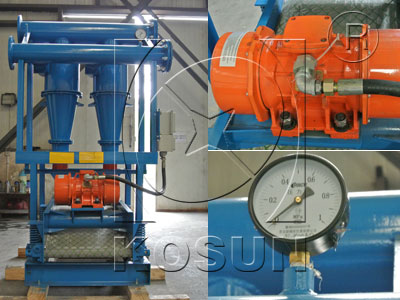What is the KOSUN desander work principle
2013-12-16
Desander have no moving parts. The larger the internal diameter of the desander is, the greater the amount of drilling fluids it is able to process and the larger the size of the solids removed. A desander with a (10 inches (250 mm) cone) is able to remove 50% of solids within the 40-50 μm (micrometre) range at a flow rate of 500 US gallons per minute (32 L/s), whilea desilter (4 inches (100 mm) Cone) is able to remove 50% of solids within the 15-20 μm range at a flow rate of 60 US gallons per minute (3.8 L/s). Micro-fine separators are able to remove 50% of solids within the 10-15 μm range at a flow rate of 15 US gallons per minute (0.95 L/s). A desander is typically positioned next-to-last in the arrangement of solids control equipment, with a decanter centrifuge as the subsequent processing unit. Drilling desanders are preceded by gas busters, gumbo removal equipment (if utilized), shale shaker, mud cleaner (if utilized) and a vacuum degasser. Desanders are widely used in oilfield drilling. Practice has proved that hydrocyclone desander is a kind equipment of economic and effective.

Desanders and desilters are solid control equipment with a set of hydrocyclones that separate sand and silt from the drilling fluids in drilling rigs. Desanders are installed on top of the mud tank following the shale shaker and the degasser, but before the desilter. Desander removes the abrasive solids from the drilling fluids which cannot be removed by shakers. Normally the solids diameter for desander to be separated would be 45~74μm, and 15~44μm for desilter. A centrifugal pump is used to pump the drilling fluids from mud tank into the set of hydrocyclones.
News
- 07-11Technical features of using KOSUN drilling waste mud treatment system
- 07-07Main equipment of solids control system in drilling
- 06-26Geothermal well mud treatment system manufacturer—KOSUN solid control
- 06-26The key to achieving mud zero discharge is on-site processing after solid-liquid separation
- 05-10Application Scenarios of KOSUN Drilling Waste Treatment Equipment
- 05-10Environmental protection new regulations require to achieve zero discharge of drilling waste
- 05-09KOSUN Solid-liquid Separation Equipment is used in the construction industry
- 04-19What are the main functions of the Mud Agitator during use?
- 04-15The Advantages of KOSUN's trenchless horizontal directional crossing mud recovery system
- 03-15Vacuum degasser is mainly divided into centrifugal degasser and jet degasser




